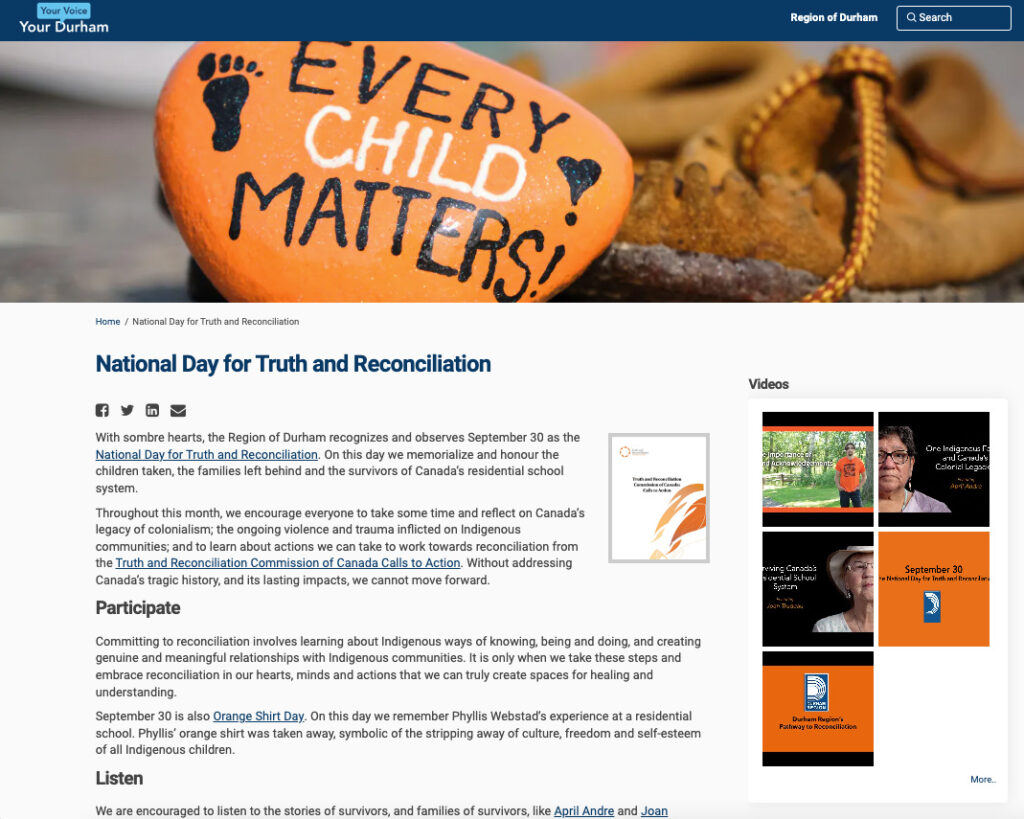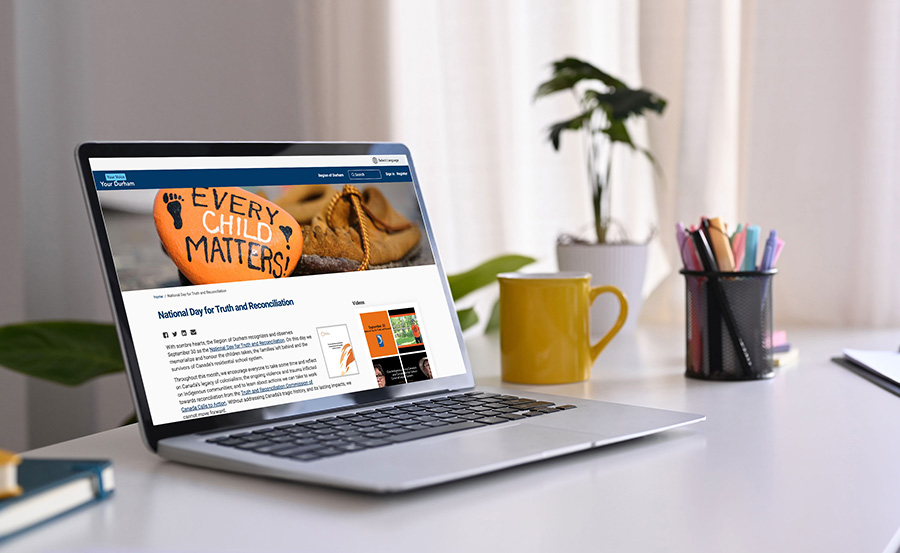Overview
With a goal of increasing participation in the National Day for Truth and Reconciliation across all communities, Durham Region, Ontario, set a goal to raise awareness around both regional events and the legacy of residential schools. EngagementHQ helped them spark conversations and build momentum for the annual commemoration.
“Adopting new technologies to facilitate engagement reaches a wider, more representative voice, leverages local expertise and lived experiences, and helps us develop and deliver policies and programs that better meet the needs of the diverse communities that make up the region.”
Alison Burgess
Director of Communications and Engagement, The Regional Municipality of Durham
SITUATION
A Need for a Consistent Engagement Platform
Recognized each year on September 30, Canada’s National Day for Truth and Reconciliation remembers the Indigenous children who never returned home from residential schools, as well as the Survivors of those schools, their families, and communities. Public commemoration of the tragic and painful history and ongoing impacts of residential schools also brings vital education opportunities about present-day cultural connections.
For Ontario’s Durham Region, that role extends to educating and inspiring the community toward taking actions in support of Truth and Reconciliation.
“Our goal was to reach the community in a flexible and engaging format that was convenient to them, anytime, anywhere,” said Alison Burgess, Director of Communications and Engagement, The Regional Municipality of Durham.
Key to that goal, Burgess said, was a consistency of messaging, using a single platform that would make it easier for residents to be familiar with events, messaging, and other resources related to the National Day for Truth and Reconciliation while also being able to engage both in conversation and provide feedback.
“As part of our broader effort to engage with residents, Durham Region looked for additional ways of connecting with the community,” she said. “The use of a single platform makes it easier for residents to be familiar and provide their feedback.

Your Durham: National Day for Truth and Reconciliation
SOLUTION
A Digital Space for Open Dialogue
Burgess’ team turned to Your Durham, a public engagement resource built using Granicus’ EngagementHQ platform, to engage the community in education and activities on truth and reconciliation. Burgess said that the site provided a way for residents to participate in Regional events, learn more about the impact and legacy of residential schools, the Truth and Reconciliation Commission Calls to Action, and also to connect with the community and share information.
“By creating digital space for open dialogue, we are providing more community members with the opportunity to share feedback and have meaningful input into the decisions that impact them,” she said. “Effective engagement often leads to a better-informed community who help to generate a spectrum of innovative ideas and diverse opinions, and concepts that drive decision-making.”
Using EngagementHQ, Durham looked to meet their two campaign objectives of increasing engagement with Indigenous communities and the public on reconciliation and furthering the understanding of Indigenous culture and heritage in the community. Tactics included releasing a weekly newsletter throughout September to page subscribers, posting informative content such as links to the Truth and Reconciliation Commission of Canada’s Calls to Action, publishing educational videos to raise awareness and understanding of topics such as the lasting impacts of the residential school system and the importance of land acknowledgements, and sharing upcoming events planned throughout Durham Region that the community could attend.
The tools within EngagementHQ allowed Burgess and her staff to not only monitor community engagement but also gain insights into how content could strengthen engagement of future campaigns.
RESULTS
A Community Partner on the Pathway to Reconciliation
The success of the Your Durham campaign during September 2022, helped reinforce both the region’s dedication to building community connections and the power of using technology to spark engagement.
During the campaign, Your Durham saw a 14.3% engagement rate, doubling the targets set for participation, a testament to the importance of conversation around issues impacting Indigenous communities, Burgess said.
“We have built community connection through this engagement page,” she added. “Durham Region is committed to reconciliation. It is only when we take steps and embrace reconciliation in our hearts, minds and actions that we can create space for healing and understanding.”
Burgess said that Your Durham will only continue to grow as a resource for the National Day for Truth and Reconciliation efforts, with a goal of increasing the subscriber list and continually connecting with the community around these issues.
“We want to be a community partner as we move along our pathway to reconciliation,” she said.
Your Durham will also be a cornerstone to other development issues in the region, as a support tool for region’s five-year strategic development plan. The platform has served as a critical component of an omnichannel engagement approach, including in-person activities and focus groups. In one instance, residents participated in virtual surveys through Your Durham, reaching approximately 2,000 residents.
The platform has also recently been used on the region’s non-police led mental health crisis response initiative, exploring a 24/7 mobile mental health crisis response program that empowers mental health professionals to lead the response. Through Your Durham, more than 1,400 community members provided feedback.
“The learnings and community built from these projects will allow us to expand our reach in the community and hopefully reach more people,” Burgess said. “This platform allowed community members who may not have been able to participate in more traditional methods of engagement to still be part of the conversation.”
More importantly, Burgess said that digital engagement will establish itself as a critical tool in connecting with the community, alongside town halls and telephone surveys.
“Community engagement is a key driver in advancing user-centered design approaches when developing Regional policies, programs and services,” she said. “We recognize that residents are not always able to engage with us using traditional channels as irregular work schedules and childcare can be barriers to in-person engagement. For community engagement to be inclusive, we recognize that it must adopt innovative technologies to meet the various needs of our community and provide multiple channels of engagement opportunities.”

